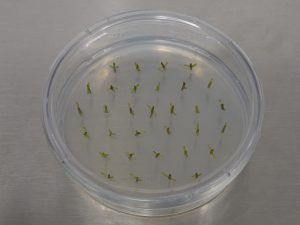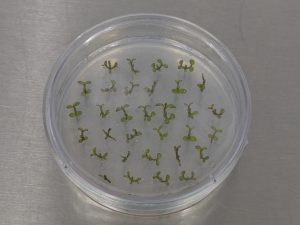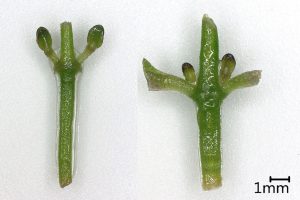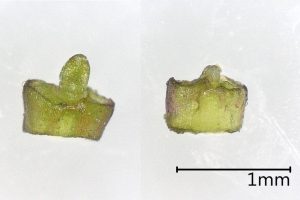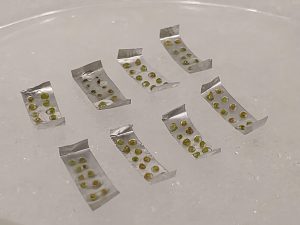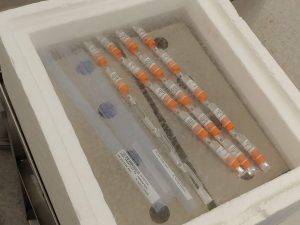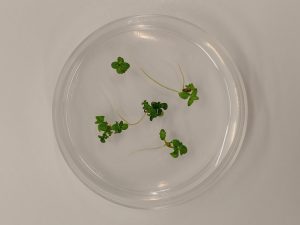Mint Shoot Tip Cryopreservation (Droplet Vitrification)

Gayle M. Volk, USDA-ARS National Laboratory for Genetic Resources Preservation (retired), 1111 S. Mason St., Fort Collins, Colorado 80521. Gayle.Volk@colostate.edu
Kim Hummer, USDA-ARS National Clonal Germplasm Repository, 33447 Peoria Road, Corvallis, Oregon 97333.
Katheryn Chen, Department of Soil and Crop Sciences, Colorado State University, 307 University Ave., Fort Collins, Colorado 80523.
Outline
- Introduction
- In vitro cultures
- Preconditioning
- Shoot tip excision
- Shoot tip processing and storage
- Shoot tip recovery
- Viability assessment
- References
- Additional information
- Acknowledgments
The mint shoot tip cryopreservation procedure is available to download here.
The mint shoot tip recovery procedure is available to download here.
1. Introduction
The USDA-ARS National Plant Germplasm System’s (NPGS) primary collection of mint (Mentha) is housed at the National Clonal Germplasm Repository (NCGR) in Corvallis, Oregon (Video 1). In addition to their diverse collection of mint maintained in the greenhouse (Fig. 1), NCGR also preserves mint as clonal propagules in tissue culture. In vitro mint cultures stored in gas-permeable bags may be kept in low-temperature, low-light conditions for one or more years before needing to be transferred onto fresh media (Fig. 2). The National Laboratory for Genetic Resources Preservation (NLGRP) in Fort Collins, Colorado serves as a secondary back-up for the NPGS mint collection.
The NCGR sends mint to the NLGRP as cultures that may either be maintained in slow growth conditions or multiplied in preparation for long-term cryopreservation. Preservation of mint in liquid nitrogen can be achieved through a variety of methods, including controlled cooling (Towill, 1988; Uchendu and Reed, 2008), vitrification (Towill, 1990), encapsulation dehydration (Sakai et al., 2000), encapsulation vitrification (Hirai and Sakai, 1999), droplet vitrification (Senula et al., 2007), and vitrification through the V-Cryoplate method (Yamamoto, 2012). This chapter describes the use of droplet vitrification to cryopreserve mint shoot tips.
Video 1. Dr. Kim Hummer, Research Leader at the National Clonal Germplasm Repository in Corvallis, Oregon provides an introduction to the National Plant Germplasm System mint collection.
Figure 1. Potted mint grown in screenhouse at NCGR in Corvallis, OR. Photo credit: Jeanine DeNoma.
Figure 2. Mint cultures in Star-Pac bags, stored at 4 oC for 1 year (right 3 bags) and 2.5 years (left bag). Photo credit: Katheryn Chen.
2. In vitro cultures
The NCGR establishes in vitro cultures of mint and prepares them for storage in slow growth conditions (low light intensity for an 8-hour photoperiod at 4 oC). Cultures are grown on Mentha Shoot Growth Medium (Murashige & Skoog (MS) Basal Medium, 30 g L-1 sucrose, 8 g L-1 agar at pH 5.8) in gas-permeable bags, and transferred to fresh media every one or two years (see “Introduction of clean plant into tissue culture” and “Reduced-temperature storage of temperate crops in tissue culture“).
When the NLGRP receives mint intended for long-term preservation, the cultures are first multiplied on Mentha Shoot Growth Medium in containers such as Magenta GA-7 vessels (Fig. 3). Cultures are maintained in an environmentally controlled growth room (~60-90 μmol m-2 s-1 with 16-hour photoperiod at 25 oC). Non-contaminated cultures are multiplied until there is enough material for cryopreservation (about 3 to 8 weeks). Approximately 170 shoot tips are needed for cryopreservation: 20 shoot tips for viability testing, and 150 shoot tips with a minimum viability of 40% (for at least 60 viable shoot tips) in long-term storage (Jenderek and Reed, 2017).
Figure 3. Two examples of mint tissue cultures. Photo credit: Katheryn Chen.
3. Preconditioning
Cutting nodal sections prior to shoot tip excision promotes uniform growth and maximizes the efficient use of in vitro material. Harvest 1 cm nodal sections from 3- to 8-week-old mint cultures (Video 2; Fig. 4). Plate these on Mentha Shoot Growth Medium in large Petri plates until axillary nodes elongate slightly (2 to 5 days)(Fig. 5). Grow with a 16-hour photoperiod (~90 μmol m-2 s-1) at 25 oC.
Although this preconditioning method is useful for a large variety of mint, some studies have found that cold acclimation is a necessary step prior to shoot tip excision (Staats et al., 2006; Senula et al., 2007; Kremer et al., 2010). If nodal sections require cold acclimation, keep them for 1 to 6 weeks in the following conditions: 16 hours of light (~60 μmol m-2 s-1) at 5 oC, and 8 hours of dark at -1 oC.
Video 2. Katheryn Chen (Colorado State University) prepares mint nodal sections.
Figure 4. Petri plate of mint nodal sections before growth period. Photo credit: Katheryn Chen.
Figure 5. Petri plate of mint nodal sections after growth period. Photo credit: Katheryn Chen.
4. Shoot tip excision
Excise shoot tips in sterile conditions using a dissecting microscope. Starting with a healthy nodal section (Fig. 6), cut 1 mm shoot tips (Fig. 7) and immediately submerge them into a room-temperature, liquid Preculture Medium (MS Basal Medium, 0.06 M sucrose at pH 5.7). Allow shoot tips to soak in this solution in the dark at 25 oC. After 24 hours, replace the first Preculture Medium with a second (MS Basal Medium, 0.3 M sucrose at pH 5.7). These should soak in the dark at 25 oC for another 24 hours. This process is shown in Video 3.
Figure 6. Two examples of mint nodal sections ready for shoot tip excision. Photo credit: Katheryn Chen.
Figure 7. Two examples of excised mint shoot tips, just under 1 mm. Photo credit: Katheryn Chen.
Video 3. Katheryn Chen excises a mint shoot tip.
5. Shoot tip processing and storage
In aseptic conditions, replace the second Preculture Medium with a room-temperature Loading Solution (MS Basal Medium, 2 M glycerol, 0.4 M sucrose at pH 5.7). Allow shoot tips to soak for 20 minutes, then replace the Loading Solution with Plant Vitrification Solution 2 (PVS2; Sakai et al., 1990) at 0 oC (Volk et al., 2006)(Video 4).
After about 20 minutes, transfer the shoot tips to PVS2 droplets on sterile strips of aluminum foil (Fig. 8). Ten shoot tips should be loaded onto each strip. After 30 minutes of exposure to PVS2, remove the excess liquid, and quickly submerge the foil into liquid nitrogen (LN). Cool labeled cryovials in LN and transfer each loaded foil strip into a vial without warming (Video 4).
While in LN, load cryovials onto cryocanes and cover with labeled sleeves (Fig. 9). Without rewarming, transfer the cryocanes into an appropriate long-term storage location, either in the liquid or vapor phase of LN.
Video 4. Katheryn Chen cryopreserves mint shoot tips using a droplet vitrification protocol.
Figure 8. Mint shoot tips in PVS2 on foil strips. Photo credit: Katheryn Chen.
Figure 9. Mint shoot tips stored in cryovials, loaded onto canes in liquid nitrogen. Photo credit: Katheryn Chen.
6. Shoot tip recovery
To conduct a viability assessment, use an LN transfer container to move target cryovials from storage to a laminar flow hood. Remove a cryovial from LN, uncap it, and quickly submerge the foil strip into room-temperature Unloading Solution (MS Basal Medium, 1.2 M sucrose at pH 5.7). Let the shoot tips soak for 20 minutes, then plate on Mentha Recovery Medium (MS Basal Medium, 30 g L-1 sucrose, 0.5 mg L-1 6-benzylaminopurine, 0.1 mg L-1 indole-3-butyric acid, 7 g L-1 agar at pH 5.7). The process is demonstrated in Video 5.
Wrap the plates and place them in the dark at 25 oC for two weeks. After two weeks, move the shoot tips to dim fluorescent light for one week (~20-30 μmol m-2 s-1), then full fluorescent light for several more weeks (~60-90 μmol m-2 s-1) before assessing survival and shoot growth.
Video 5. Katheryn Chen warms and recovers mint shoot tips that were cryopreserved using a droplet vitrification technique.
7. Viability assessment
After several weeks on the Mentha Recovery Medium, viable shoot tips should have grown into small plants (at least 4 mm)(Video 6). These should exhibit healthy shoot growth and could show root structures (Fig. 10). Each shoot tip can be evaluated on a binary scale to determine success of the cryopreservation process. In order to consider the accession successfully preserved, viability should ideally meet a 40% minimum, ensuring that each stored vial contains at least one surviving shoot tip (Jenderek and Reed, 2017; Volk et al., 2017).
Video 6. Silent, time-lapse video of mint shoot tips growing after droplet vitrification and cryo-exposure, courtesy of Katheryn Chen.
Figure 10. Cryopreserved mint shoot tips rewarmed and recovered for 5 weeks. Photo credit: Katheryn Chen.
8. References
Hirai D & Sakai A. 1999. Cryopreservation of in vitro-grown axillary shoot-tip meristems of mint (Mentha spicata L.) by encapsulation vitrification. Plant Cell Reports 19:150-155.
Jenderek MM & Reed BM. 2017. Cryopreserved storage of clonal germplasm in the USDA National Plant Germplasm System. In Vitro Cellular & Developmental Biology – Plant 53:299-308.
Kremer C, Martin C, Senula A, Keller ERJ, Gonzalez-Benito ME. 2010. Cryopreservation of mint in vitro-apices: Effect of preculture and cooling procedures. Cryobiology 61:402-402.
Sakai A, Kobayashi S, Oiyama I. 1990. Cryopreservation of nucellar cells of navel orange (Citrus sinensis Osb. var. brasiliensis Tanaka) by vitrification. Plant Cell Reports 9:30-33.
Sakai A, Matsumoto T, Hirai D, Niino T. 2000. Newly developed encapsulation-dehydration protocol for plant cryopreservation. CryoLetters 21:53-62.
Senula A, Keller ERJ, Sanduijav T, Yohannes T. 2007. Cryopreservation of cold-acclimated mint (Mentha spp.) shoot tips using a simple vitrification protocol. CryoLetters 28:1-12.
Staats ER, Towill LE, Laufmann J, Reed BM, Ellis DE. 2006. Genebanking of vegetatively propagated crops: Cryopreservation of 44 Mentha accessions. Cryobiology 53:425-425.
Towill LE. 1988. Survival of shoot tips from mint species after short-term exposure to cryogenic conditions. HortScience 23:839-841.
Towill LE. 1990. Cryopreservation of isolated mint shoot tips by vitrification. Plant Cell Reports 9:178-180.
Uchendu EE & Reed BM. 2008. A comparative study of three cryopreservation protocols for effective storage of in vitro-grown mint (Mentha Spp.). CryoLetters 29:181-188.
Volk GM, Harris JL, Rotindo KE. 2006. Survival of mint shoot tips after exposure to cryoprotectant solution components. Cryobiology 52:305-308.
Volk GM, Henk AD, Jenderek MM, Richards CM. 2017. Probabilistic viability calculations for cryopreserving vegetatively propagated collections in genebanks. Genetic Resources and Crop Evolution 64:1613-1622.
Yamamoto S, Rafique T, Fukui K, Sekizawa K, Niino T. 2012. V-cryo-plate procedure as an effective protocol for cryobanks: case study of mint cryopreservation. CryoLetters 33:12-23.
9. Additional information
The mint shoot tip cryopreservation procedure is available to download here.
The mint shoot tip recovery procedure is available to download here.
10. Acknowledgments
Citation: Volk GM, Hummer KE, Chen KY. 2021. Mint Shoot Tip Cryopreservation (Droplet Vitrification). In: Volk GM (Eds.) Training in Plant Genetic Resources: Cryopreservation of Clonal Propagules. Fort Collins, Colorado: Colorado State University. Date accessed. Available from https://colostate.pressbooks.pub/clonalcryopreservation/chapter/mint-cryopreservation/
This training module was made possible by:
Editors: Katheryn Chen, Gayle Volk
Content providers: Katheryn Chen, Kim Hummer
Videographers: Ashley Shepherd, Katheryn Chen
This project was funded by the USDA-ARS and by the USDA-NIFA Higher Education Challenge Program grant 2020-70003-30930.
USDA is an equal opportunity provider, employer, and lender. Mention of trade names or commercial products in this article is solely for the purpose of providing specific information and does not imply recommendation or endorsement by the U.S. Department of Agriculture.




